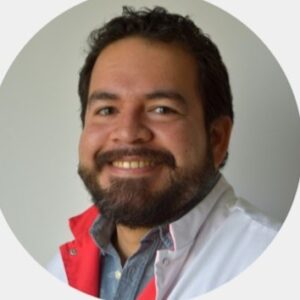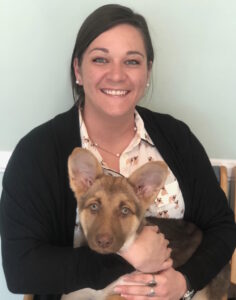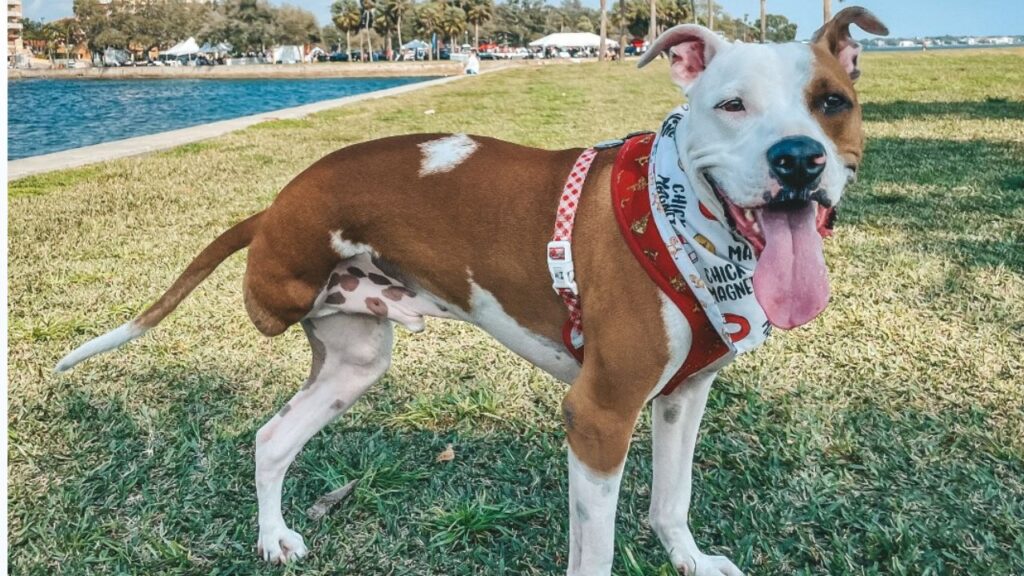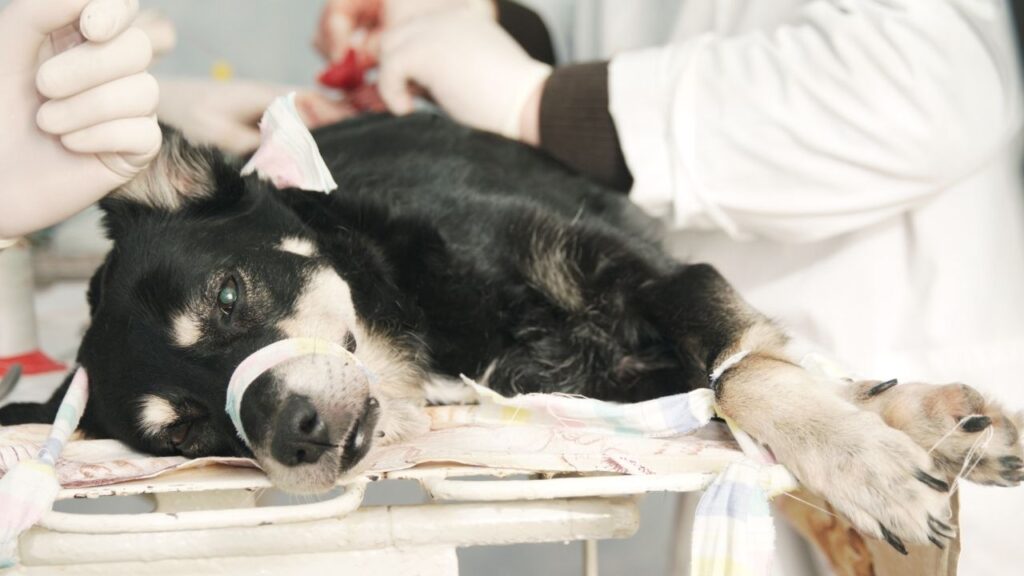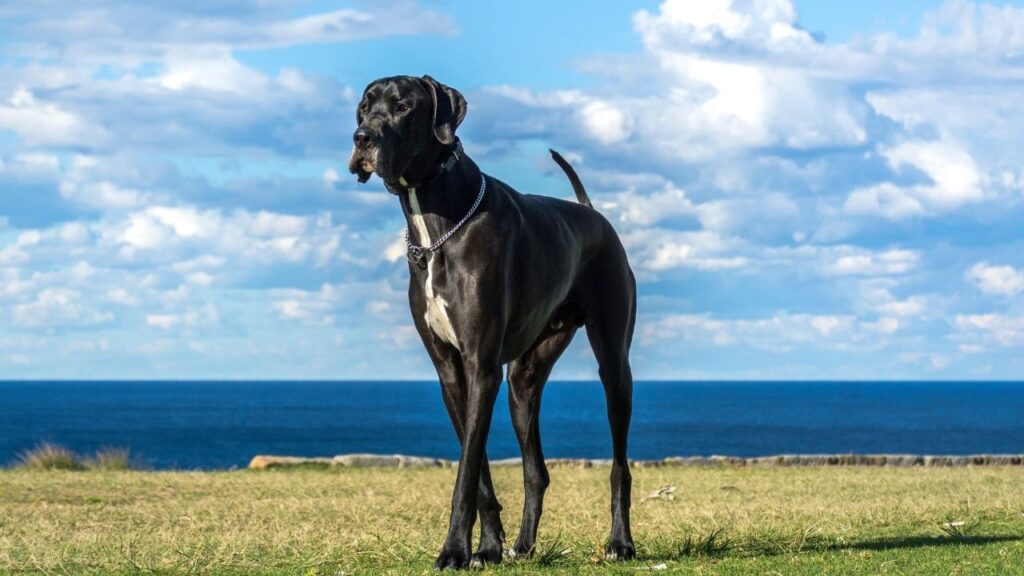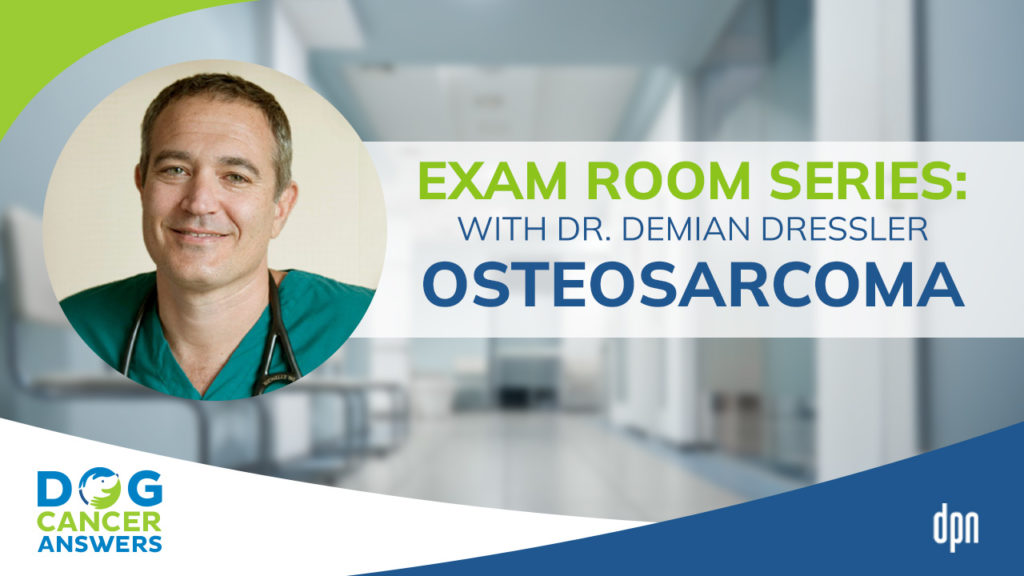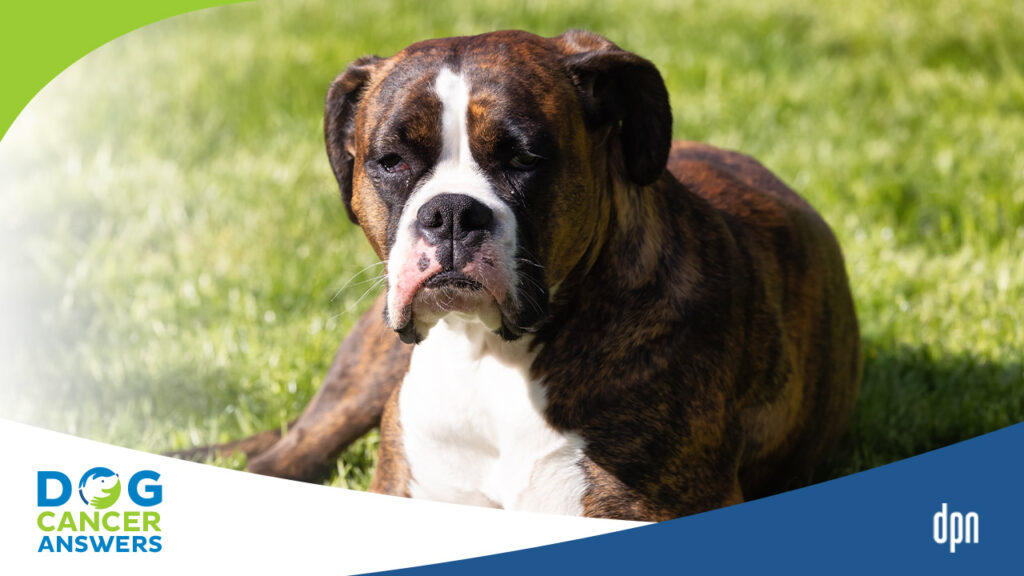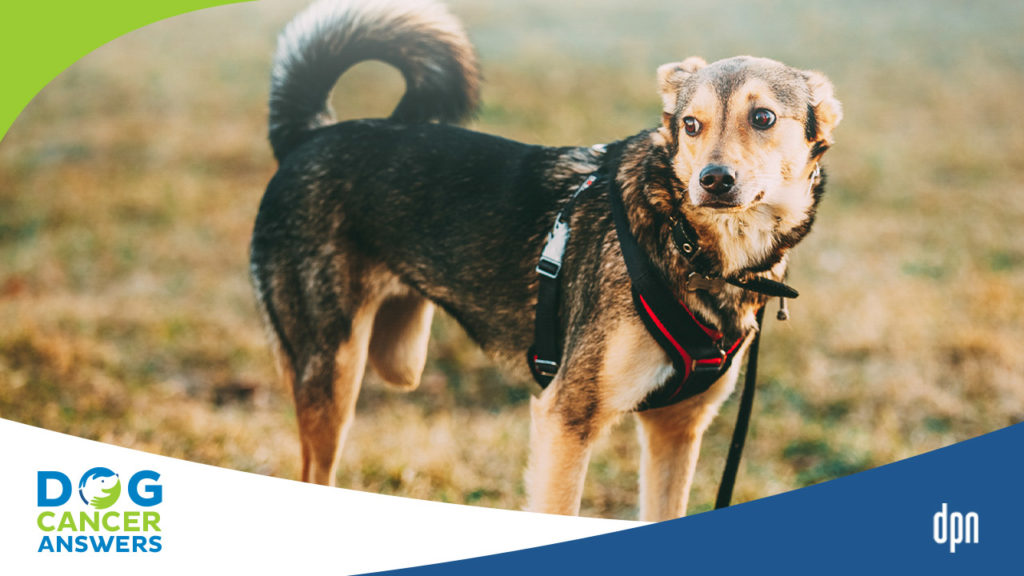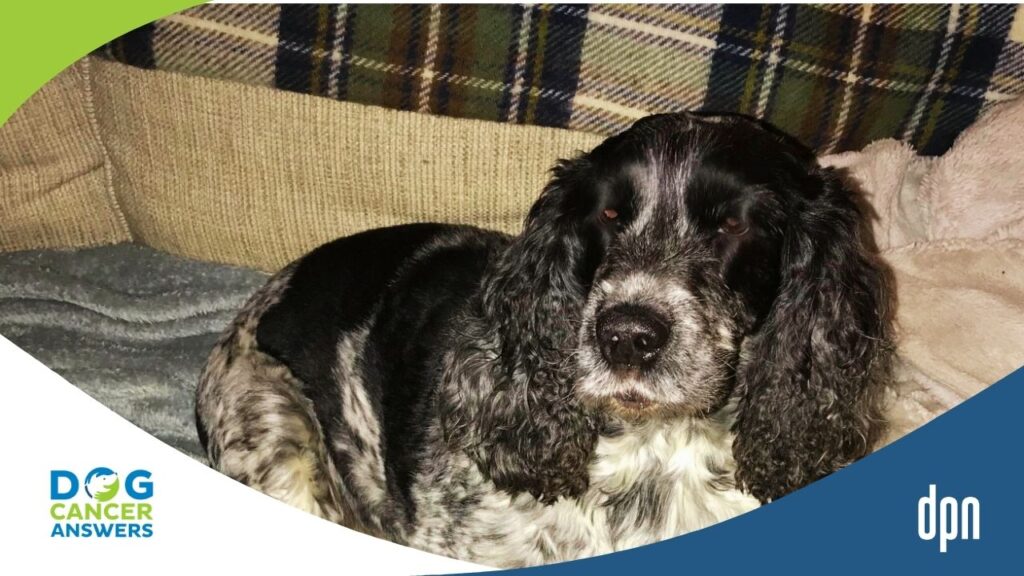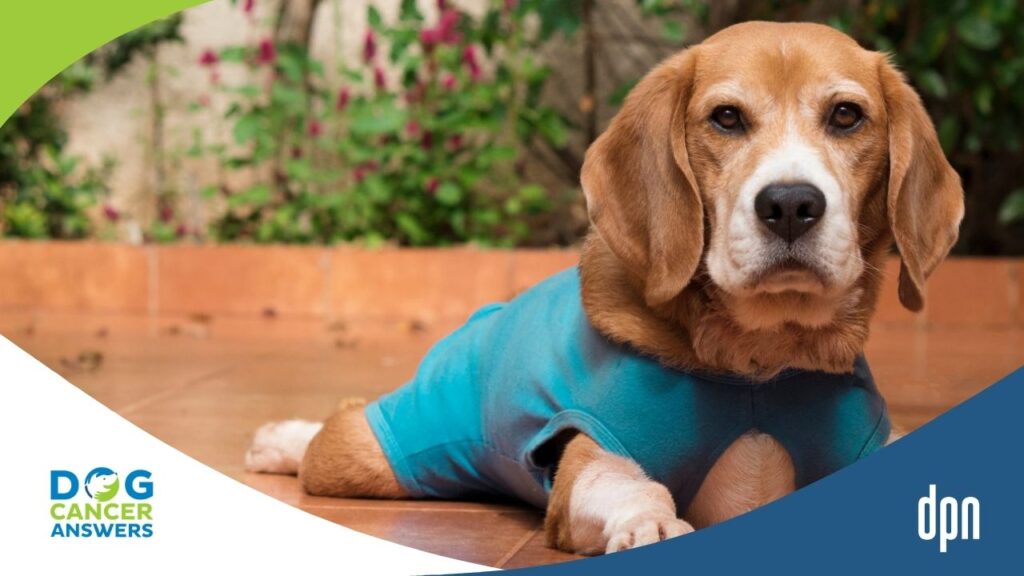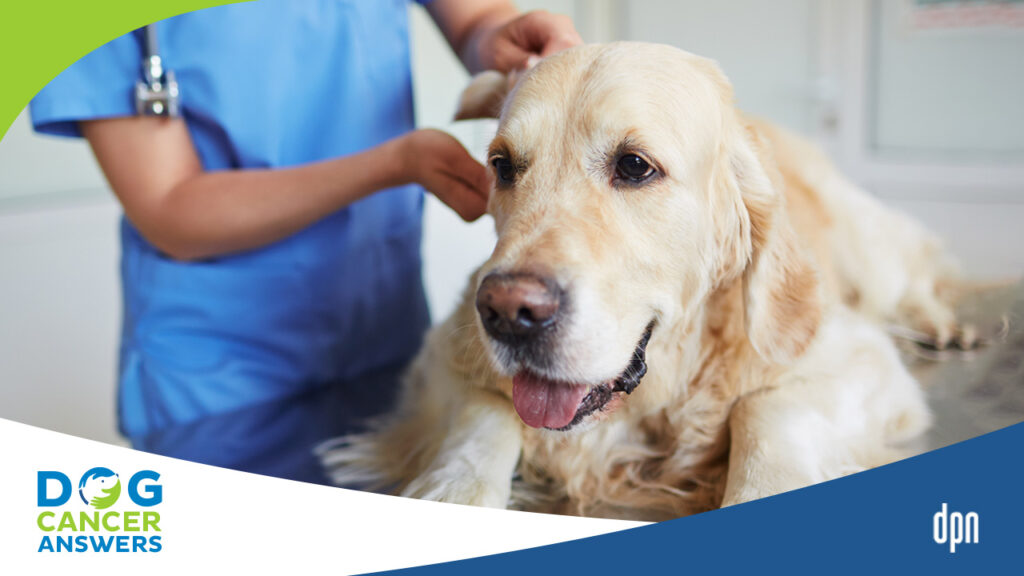EPISODE 236 | RELEASED January 8, 2024
BIOCERA-VET Cementoplasty for Dog Bone Cancer | Aqui Villamonte Chevalier, DVM, PhD & Dr. Shaina Stewart
Cementoplasty has helped humans stabilize bones for decades. Now it’s being used in dog bone cancer.
SHOW NOTES
Osteosarcoma in dogs is bad news upon bad news. First, you hear your dog has cancer. Second, you hear that the best treatment is amputation. WHAT?? It’s depressing and scary as heck.
Well, there’s a brand-new treatment (to veterinary medicine) available: bone cement. Cementoplasty has been used to help stabilize human bones for decades … and now it’s being used in dogs with bone cancer.
Join us for a deep dive into the bare bones, elegant technique offered by TheraVet S.A., a company headquartered in Belgium. Their new compound, BIOCERA-VET, is ready for use in the U.S. Veterinarian and imaging whiz Aquilino Villamonte Chevalier joins us from the company to explain how their product works and what to expect if you try to save your dog’s limb.
We’re also joined by Dr. Shaina Stewart, a general practice veterinarian from North Carolina who’s one of the few veterinarians using this technique in the United States. The pain relief and support cementoplasty offers to her patients may be worth considering.
Call +1 808-868-3200 to leave a question on our Listener Line for a future show!
>> Dr. Shaina Stewart: As it filled the cavity, it started to push the applicator out. So I was like, I guess I know it’s filling well because it’s pushing me out of here. So, perfect.
>> Announcer: Welcome to Dog Cancer Answers, where we help you help your dog with cancer.
>> Molly Jacobson: Hello friend, I’m Molly Jacobson. Today on Dog Cancer Answers, we’re talking about a new palliative option for osteosarcoma that’s making its way to the U.S. from Europe. The company TheraVet has developed a product called BIOCERA-VET that is injected into cancerous bone to strengthen it and provide both support and pain relief.
To explain how this incredible cementoplasty procedure works, we’re joined by Dr. Aqui Villamonte from Belgium and Dr. Shaina Stewart from North Carolina. Dr. Stewart is the first vet to do this procedure in the U.S. Dr. Aqui, Dr. Stewart, thank you. so much for joining us today.
>> Dr. Shaina Stewart: Good to be here.
>> Dr. Aqui Villamonte Chevalier: Thank you for having us.
>> Molly Jacobson: Dr. Villamonte, you asked me to call you Dr. Aqui, is that okay?
>> Dr. Aqui Villamonte Chevalier: Yes. It’s perfect.
>> Molly Jacobson: So we’re talking about cementoplasty, which just sounds like the most incredible, simple solution to bone fractures that I can imagine.
Like, why don’t we just put cement in it? So I was wondering how this happened. Who came up with this brilliant idea?
>> Dr. Aqui Villamonte Chevalier: Well, this is actually a technique that comes from the human medicine and we are now since a couple of years starting to implement in. veterinary medicine. And in the United States, uh, Dr. Stewart is the pioneer. Uh, but, uh, I think the first reports in, of cementoplasty date of the 80s, ’84, I think it is. And it started in human medicine for the, um, vertebroplasty to fill cavities caused by tumors or metastasis of tumors, or even, uh, in cases of compression fractures, it’s quite used also. And it’s usually used with PMMA, polymethyl methacrylate.
It’s a special bone cement that becomes quite hard. Our product is a medical device, so it’s not active on the body. It’s just a bone cement that you’re going to fill a cavity with. And in the process of filling that cavity, you are extracting as much of the tumor as possible. And that’s the way it works. And that’s what, uh, the cementoplasty is in a nutshell.
>> Dr. Shaina Stewart: Ironically enough, that’s how I came to discover it here in the U.S. A friend of mine is a medical assistant at a spine and radiology center and she was telling me about the kyphoplasty and verteboplasty they were doing for osteoporosis with compression fracture in people.
As bones get weak, older people are really susceptible to just compression fracture. So she was telling me about this and I was like, I wonder, if there’s something like that in dogs and I was like, Oh, look at this. And it just, uh, this was February, March and I looked or it was, it was very close to when it became available in the U.S., um.
>> Molly Jacobson: Of this year?
>> Dr. Aqui Villamonte Chevalier: Last year.
>> Dr. Shaina Stewart: Yes, last year. The first one I did was in early December, I believe. So it was just a few months prior that I had discovered everything. So the timing really worked out.
>> Molly Jacobson: That’s really cool. So just so that we’re clear on the timeline, when did you first discover, what month did you first discover cementoplasty?
>> Dr. Shaina Stewart: I want to say November.
>> Molly Jacobson: So this is really new, in the U.S.
>> Dr. Shaina Stewart: Yeah, in the U.S. Certainly.
>> Dr. Aqui Villamonte Chevalier: Yeah. In Europe, it’s also very new. We had a different formula of the product before, and we launched it in June of 2021. And in July of 2022, we launched the new formulation, which is ready to use. So in the previous version, you had to mix it yourself inside a syringe and then push it in.
>> Molly Jacobson: Okay.
>> Dr. Aqui Villamonte Chevalier: And the setting time was not forgiving. You had to do things very fast. And, uh, then we changed new formulation, which is much more ergonomic in which comes ready to use in a syringe. You just have to connect the adapters and inject.
>> Molly Jacobson: Wow.
>> Dr. Aqui Villamonte Chevalier: And, uh, that, uh, gives you a prolonged time. So it’s much more workable and allows the vet to really, you know, why do they put, perform the cementoplasty? They can evaluate the filling with the radiographs or fluoroscopy depending on what they have at hand.
>> Molly Jacobson: And then go back in and sort of fine tune things if they need to.
>> Dr. Aqui Villamonte Chevalier: Yeah. Yeah. The idea is you fill a little bit and you check. You a little, go a little bit more out. It’s, uh, you fill a little bit more, you check always on two views to be sure that you’re filling as well as in the front, as in the back and to the sides. So it’s, uh, it’s a process.
>> Molly Jacobson: How incredible. So walk us through. Walk us through the procedure from beginning to end. Is the dog anesthetized? Do you have to cut open to get to the bone? Can you just stick the syringe through the muscles? How does it work?
>> Dr. Aqui Villamonte Chevalier: I think Dr. Stewart is the surgeon. I’m not the surgeon.
>> Molly Jacobson: Yeah. Let’s hear from the, let’s hear from the hands on expert.
>> Dr. Shaina Stewart: So we do not have fluoroscopy. So we definitely did a lot of pre-op planning. So the dog is anesthetized and I actually use sterile surgical staples as my markers for planning as I was getting pre-op radiographs.
>> Molly Jacobson: Okay.
>> Dr. Shaina Stewart: So, unfortunately, we didn’t have fluoroscopy, but we were still able to.
>> Molly Jacobson: What is fluoroscopy?
>> Dr. Shaina Stewart: So that’s a real time radiograph.
>> Molly Jacobson: Oh, okay.
>> Dr. Shaina Stewart: So, so you’re, you’re seeing what’s happening in real time versus snapshots in time.
>> Molly Jacobson: So it’s like a movie version of an x-ray rather than a photograph version of an x-ray.
>> Dr. Shaina Stewart: Yes.
>> Molly Jacobson: Okay.
>> Dr. Shaina Stewart: Unfortunately, it’s quite expensive and not readily available, but, uh, we make it work without it. So with this, uh, depending on which bone you’re working with and where the site is, you, the animal is anesthetized. You do make an incision based on your planning on how you’re going to approach the bone, but it’s typically, a very small incision, one or two inches.
>> Molly Jacobson: Okay.
>> Dr. Shaina Stewart: We just need to access that bone in order to drill a small hole, access hole, to get to the tumor and remove as much tumor as we can and then inject product.
>> Molly Jacobson: So you go in, you remove the bone tumor and then you fill up the hole.
>> Dr. Shaina Stewart: Once you have that access point and the correct angle, you can kind of tell when you’re, getting into that bone tumor. It just feels a lot different. And then, um, we used a lot of surgical flush, suction. We actually sterilized bottle brushes and used that to kind of decorticate tumor and get it out.
>> Molly Jacobson: To scrub out the inside of the bone, basically.
>> Dr. Shaina Stewart: Essentially. And that was just, uh, innovative thought, you know, like we wish we could just scrub this out. And I was like, we can.
>> Molly Jacobson: We could. We have the tool. It’s called a bottle brush. That’s incredible.
>> Dr. Shaina Stewart: Yeah. Once, um, you’re satisfied that you’ve removed as much as you can and you have a nice cavity to fill, you just put the adapter on the syringe and, um, the first time I did it, uh, I just started, you twist it, you don’t push it, and as I twisted, as it filled the cavity, it started to push the, um, applicator out.
So I was like, I guess I know it’s filling me well because it’s pushing me out of here. So, perfect.
>> Molly Jacobson: Oh, and then you take an x-ray or a radiograph to verify that you’ve gotten it in.
>> Dr. Shaina Stewart: Correct.
>> Molly Jacobson: Well, that’s really fascinating. And then how long does it take to harden?
>> Dr. Aqui Villamonte Chevalier: So normally in 24 hours. So the product becomes too harden only when it is in contact with fluids.
>> Molly Jacobson: Oh.
>> Dr. Aqui Villamonte Chevalier: Call it blood, call it body fluids, uh, water. If you want to make an experiment on your tables. But the moment that the product has contact with, uh, fluids, then, uh, the crystallization reaction will start to happen. So that moment starts the setting. After 15 minutes that the product is in contact with a fluid, you will start to see that there’s like a crust forming on it.
And at 24 hours for such high volumes as the one that are injected in osteosarcoma, you will have a hardness comparable to cancerous bone. So we’re talking about between the 10 and a 25 megapascals, which is already very good. And after four days, because we’re talking about big volumes in osteosarcoma, you will have 45 megapascals, which is extremely hard.
>> Molly Jacobson: Wow.
>> Dr. Aqui Villamonte Chevalier: It’s become very, very hard. And it’s designed to hold these compression forces on long bones, which will be the weight bearing forces that will occur on the bone. And what the product does is to withstand these forces exerted, uh, on the bone and alleviate the pain this way.
>> Molly Jacobson: So relieving pain is the number one goal.
>> Dr. Aqui Villamonte Chevalier: Yes. I think that the main goal of the cementoplasty in both humans and our dear, uh, four legged friends is to alleviate the pain and increase the quality of life of the patient.
>> Molly Jacobson: Right.
>> Dr. Aqui Villamonte Chevalier: There’s no other reason to do it. We are not trying to cure because we are not going to cure the cancer. We are trying to improve the quality of life to be the palliative care for these patients who are most definitely in need of a solution.
>> Molly Jacobson: Okay. Dr. Stewart, would you use this instead of amputation?
>> Dr. Shaina Stewart: Yes. So the first patient I used it on actually came to me because he was 96 pound, really long legged dog, and, um, it was a forelimb that what he had the bone tumor in and dogs bear 60 percent of their weight forelimbs, 40 percent on the back, so that much weight losing a forelimb, it’s really tough for those dogs and the owner did not want to amputate and I had just found the bone cement weeks prior and I said, Hey, we can try this.
>> Molly Jacobson: Hey, I’m kind of a cowboy. Let’s try this.
>> Dr. Aqui Villamonte Chevalier: Exactly. Yeah.
>> Dr. Shaina Stewart: That’s kind of how it worked out. I said, we’re, we’re going to be winging it a little, but if your game big is at the end of the day, if this doesn’t work for whatever reason, he loses his leg, which is what’s going to happen anyway. So, and she was like, absolutely, let’s try. And it’s fortunate we did because Colt took a spill a couple weeks ago and injured his other wrist, the opposite foreleg. So he was actually limping. on the leg we had filled with bone cement for a couple of weeks.
He’s, he’s recovered now, but he definitely scared me. Certainly when I heard he was coming in for four limb lameness, but she was like, no, no, he sprained his other wrist chasing a ball. I was like.
>> Molly Jacobson: And the bone cement is making the leg that had osteosarcoma tumors in it. Fine. It can hold his weight.
>> Dr. Shaina Stewart: It can hold his weight. It can kind of carry the team for the front half with an injured opposite forelimb.
>> Molly Jacobson: Now, Dr. Aqui, you mentioned that you’re not trying to cure the cancer with us. Can you explain a little bit about why, how it’s not a cure?
>> Dr. Aqui Villamonte Chevalier: Well, osteosarcoma is not a cancer that you can cure. Most of the time you’re not treating to cure cancer, osteosarcoma. We’re trying to give a palliative treatment to diminish the presence of, uh, metastasis, and we do that by giving chemotherapy. We are not offering a cure because we are not there yet, but once the medicine gets there, I’m quite sure that we will get on the boat and add the curative medicine to the product.
At this stage, we are already started. Uh, to find a way to mix the product with the chemotherapy that is normally given.
>> Molly Jacobson: Oh.
>> Dr. Aqui Villamonte Chevalier: Cisplatin, uh, carboplatin. We’re in the process of finding the way to mix them so that the vet can deliver locally some treatment. And this way, probably not only increasing the quality of life, but prolonging the period of time in which their metastasis will appear.
>> Molly Jacobson: That’s interesting.
>> Dr. Aqui Villamonte Chevalier: So this will need a lot of time and, and care and loving care. But, uh, I think that, uh, we are on the good path and we are moving along with key opinion leaders that give us their opinion on, on the oncology part, which is very important because to be honest, uh, surgeons are more like cowboys, like, uh, Dr. Stewart, but, uh, oncologists are more, uh. apprehensive when you tell them that instead of eliminating the tumor, you’re going just to eliminate one part of it by clearing the cavity and then replace it with a bone substitute or bone cement.
>> Dr. Shaina Stewart: I have been looking into some pretty interesting osteosarcoma specific information, and there is, um, surgery accelerated metastasis. So, when you amputate osteosarcoma, there’s always, small tumor cells in circulation that break off of the primary tumor. And, um, without getting too nerdy about it, I guess, there are cells in the lungs that when you amputate, change and.
>> Molly Jacobson: Specifically that react to amputation and then become more likely to be sites for metastasis?
>> Dr. Shaina Stewart: There are macrophages, which are inflammatory cells that gobble up things that shouldn’t be there, like osteosarcoma cells. And for some reason, when you amputate primary tumor, those cells in the lungs change and become more likely to go after these. So, I feel like there is some actual benefit versus risk to leaving the tumor or some of the tumor, specifically with osteosarcoma.
>> Dr. Aqui Villamonte Chevalier: Just to add a little bit on what Dr. Stewart said is that during this meeting at the European Congress on Oncology, I also discussed with other oncologists who are very interested in the technique just because there’s this theory that says that by keeping the limb, you’re still keeping the inflammatory signal that is controlling the tumor where it is and avoiding this metastasis to appear either in the lungs or secondary bones.
So I think that the cementoplasty is getting in the focus for discussion. It’s not that they are not behind it. It’s just that they need more information what or what is happening at the location and how is this really helping or not?
>> Dr. Shaina Stewart: The more dogs we get with bone cement, the more we can compare those to amputees.
>> Dr. Aqui Villamonte Chevalier: Yeah. Exactly.
>> Dr. Shaina Stewart: And I just, I don’t think there’s quite enough dogs yet to make that comparison.
>> Dr. Aqui Villamonte Chevalier: No, not yet. And the thing is that, uh, even when we need very large number of dogs, because we don’t have an homogeneous population, we do not have the same breed, same age, same level of, uh, of advancement of the tumor. Then we don’t have the same surgeon, which is a big factor always in the study.
You have to be as homogeneous as possible. So we really need a large number of patients. So it’s, uh, it’s difficult to, it’s difficult, but we’re on the way and, uh, I think, uh, we’re going to publish very soon an article based on the first, uh, formulation that we used. And, uh, we did a short study on it that showed that there was an increasing quality of life in the patients.
And, uh, we keep gathering cases like Dr. Stewart, who is very reactive with us and she is collaborating with us and she’s, uh, feeding us images and, and the clinical part of the patients. And like Dr. Stewart, we have a couple of vets also in Europe who are doing the same. So we are gathering these cases.
>> Molly Jacobson: Did Colt, your first patient, Dr. Stewart, also get chemotherapy? Are you continuing to do other standard of care for osteosarcoma patients?
>> Dr. Shaina Stewart: He did get six rounds of carboplatin, which is, at least in the U.S., the kind of standard course following amputation. We started that, I think, five days after his bone cement because you don’t have to wait as long to start chemotherapy because there’s not such a massive incision that needs to heal.
So he did get chemo in addition to the bone cement. There is an immunotherapy where you submit tumor and the company I’m familiar with is Toragen, but they haven’t recommended using immunotherapy. In conjunction with bone cement, because the primary tumor is still there, so you don’t really want to train the immune system to go after tumor when, when your primary is still there.
And then radiation is also an option.
>> Molly Jacobson: How long is the recovery period after you sew the dog back up and send him on his way? Is it the normal surgical recovery times and anything people need to look out for?
>> Dr. Shaina Stewart: With all of the dogs that have gotten the procedure, they do stay overnight on a constant rate infusion of pain medication.
Some people will splint limbs. I have not just because they’re not really moving around much and it hardens so quickly. And then Colt, I did have them restrict activity for 10 days, even though it was fully hardened in four days, just because I was being a little wimpy about it, but he walked out of the hospital 24 hours later, better than he walked in.
>> Dr. Aqui Villamonte Chevalier: Most of the dogs do go out walking the next day with some limping still, and they improve gradually in time. But there are also dogs who take more time to start walking back on that limb, especially in proximal shoulders, uh, distal femurs where the voids and the bone lesions was massive, especially when there is a lot of muscle mass involved.
There’s also a soft tissue inflammation component that we don’t have to forget about. And it’s most, some cases in which we had a very nice feeling of the cavity and, uh, the dog comes back, uh, and has to be amputated or euthanized just because the osteosarcoma keeps working how it works and causes an inflammation of the soft tissue. But eventually it’s too much to work on it.
>> Dr. Shaina Stewart: I unfortunately have had that experience as well. I am a little more cautious with tumors that seem to be more proliferative versus lytic.
>> Molly Jacobson: Define those two words, proliferative and lytic, for our listeners.
>> Dr. Shaina Stewart: Proliferative is growing, making more bone, kind of like a plant would bloom out. Lytic is the tumors chewing up the bone, so you’re just losing. bone.
>> Molly Jacobson: Okay.
>> Dr. Shaina Stewart: Both are painful and if you can remove that proliferative lytic, whichever it may be, and put in the bone cement, you’re making them more comfortable, but the more proliferative tumors or the tumors that behave that way, there’s only so much room for them to expand before they’re impinging on soft tissues and Even though they’re not the bone isn’t painful because it’s stabilized. It’s making it everything else around it painful.
>> Molly Jacobson: I see. So a proliferative tumor might not be a good candidate.
>> Dr. Shaina Stewart: I would discuss it with the owner I’m concerned this may happen and If you have financial concerns, then you might want to skip this and go straight to amputation but I wouldn’t be opposed to trying because cancer does what it wants, and I’m never gonna make that call and rule a dog out, because you never know.
>> Molly Jacobson: A lot of listeners really do appreciate veterinarians who lay out all the options that are available and then let them make the choice, rather than excluding things.
>> Dr. Shaina Stewart: That’s one reason I I was drawn to veterinary medicine as there’s so many new things happening right now and so many things to try. And as long as there’s research behind it and first, do no harm, I’m game to try it.
>> Dr. Aqui Villamonte Chevalier: As a company, when you launch a product, uh, and you need people to try it and to stand behind it in front of a pet owner, it’s, uh, It’s nice to have someone like Dr. Stewart that, uh, is, how you say it? I’m having the word in Dutch in my head, but not in English.
>> Molly Jacobson: Someone who’s innovative.
>> Dr. Aqui Villamonte Chevalier: Yeah. Innovative. Yeah. I will just also say that every time they will get a question, either from a pet owner or a vet, we always give them back feedback, especially to vets. Pet owner, I will not give the same kind of feedback like, you should do this in the surgery, but the pet owners, we try to direct towards a vet in their region who’s doing the technique and with vets, what we do is be completely sincere, completely open and say, look, this is not a good candidate, don’t use the product.
We are not there just to sell. We are there to help you on the way.
>> Molly Jacobson: I’m so sorry, but before we go there, because that’s an important thing I want to talk about, let’s take a quick break and listen to our sponsors. And we’ll be right back with Dr. Aqui talking about which dogs might not be good candidates for this procedure.
And we’re back. So what dogs would you say are not good candidates, Dr. Aqui?
>> Dr. Aqui Villamonte Chevalier: Well, what we suggest as the minimum necessary is that you still have one cortical intact. So imagine a round bone and the osteosarcoma has been eating all of the sides, the cranial part, the front part, the lateral and the medial part, but you still have something on the back. Well, the product needs to give support to something.
>> Molly Jacobson: Right? If there’s a full break in that bone, this is not going to fill it in. There has to be something to fill it in.
>> Dr. Aqui Villamonte Chevalier: There have been cases where they have tried and the dog is doing fine for some weeks, and then not anymore because we’re not supporting anything is the only the product is supporting that bone.
And the moment that the osteolysis keeps advancing, then the product cannot keep up. So the main idea is that you have at least one cortical bone intact to which you are going to provide support and that the patient doesn’t have metastasis. Because, uh, if the patient has metastasis, well, the, the prognosis is very bad.
>> Molly Jacobson: How many dogs who are newly diagnosed with osteosarcoma would you think might be eligible for this?
>> Dr. Shaina Stewart: I think one of the biggest things is, um, where in the course of disease the dog is. So if an owner immediately sees their dog limping and brings them in and it’s diagnosed, they’re much more likely to be a candidate because it’s early on much less likely to have metastasis. Much less likely to have a situation where we can’t use the product because there’s so much tumor there.
So I think having owners that get their limping dog in really quickly gives us the best chance of being able to offer that option.
>> Molly Jacobson: I imagine dogs still need to be on pain medications.
>> Dr. Shaina Stewart: Staying on pain medication or an anti inflammatory in the patient population we run into. They probably need it anyway. So, um.
>> Dr. Aqui Villamonte Chevalier: There’s always a soft tissue component, especially in proximal humerus, distal femur, proximal tibia. The soft tissue component, uh, we are not solving, unfortunately, so there’s always some kind of pain.
Distal radiuses and distal tibias are the ones that we have seen that do not require that much, um, post care. However, we know that some vets use disinflammatories as part of the treatment of the cancer. So it’s, uh, even if it is not related to pain, there are some disinflammatories involved in the treatment of the dog.
>> Molly Jacobson: So what are the costs associated with cementoplasty?
>> Dr. Shaina Stewart: Depending on your area and the vet you choose, I would expect it to be comparable to the cost of a limb amputation.
>> Molly Jacobson: Okay. So where do listeners go if they want to know if their dog’s a candidate? Who’s doing this besides you, Dr. Stewart?
>> Dr. Shaina Stewart: I’m a general practitioner, so I think universities and referral centers are probably not as ready to jump on something new and try it because that’s just kind of the nature of the beast.
>> Molly Jacobson: There’s plenty of veterinarians, I’m sure. We have a lot of veterinarians who listen to our show and I’m sure that their ears are perking up and there’s more than one cowboy out there. So.
>> Dr. Aqui Villamonte Chevalier: I’m sure of it.
>> Dr. Shaina Stewart: My, my, my, my life motto is, uh, it’ll probably be fine. So, uh, go for it.
>> Molly Jacobson: I love it. All right. And then in terms of if a veterinarian were interested in offering this, is there special training that you offer at TheraVet, Dr. Aqui?
>> Dr. Aqui Villamonte Chevalier: Well, we have designed based on the experience of the surgeons who have been doing the surgery for the last two years. We have put together a step by step guide if a vet wants to, to have some advice or discuss the technique.
I’m an email away, uh, a call away and I’m always available. So everything’s on the step by step guide, the tips and the tricks and the mindset that you have to have.
>> Molly Jacobson: Which countries in Europe currently offer cementoplasty?
>> Dr. Aqui Villamonte Chevalier: We have what we call, uh, the Osteosarcoma Centers of Excellence. That’s a network of vets who have performed the technique and they are based in Belgium, Netherlands, France, the UK, Ireland, Scotland, but the product is readily available to be sent worldwide.
I think it’s a nice solution, a solution, palliative treatment. Let’s not forget it. But it’s a nice option for vets because normally what do we have now is giving bad news, on bad news. So giving them this option of having a dog still on four legs for the same time that they will be on three legs, well, let’s try.
>> Molly Jacobson: Well, I have so enjoyed learning about cementoplasty with the two of you. I’m wondering if you have any last words of advice for dog lovers facing osteosarcoma, about cementoplasty or any other advice you have.
>> Dr. Aqui Villamonte Chevalier: Maybe my advice as a vet and as a dog lover will be, um, it is not the end of the world. There are options. Here we are offering one of them, not the only one. So keep an open mind and keep pushing through what it’s expecting in the short future because dogs with bone tumors will suffer and the families will also suffer. And the vets are suffering constantly about it also because they have not much to offer. So I think it’s, uh, something that we have to do all together and push towards a better solution, better approach altogether.
>> Molly Jacobson: Dr. Stewart?
>> Dr. Shaina Stewart: In the end, do what’s right for your pet. What’s best for your pet. What’s best for you. What’s best for your family. And whatever that looks like. There’s never a right or wrong answer when it comes to these things. But, there are options available. And, when you get a diagnosis, don’t take that at face value.
Take a little time, process, and see what’s out there and um, don’t make any snap judgments.
>> Molly Jacobson: That is excellent advice from both of you. Thank you so much for joining us today.
>> Dr. Aqui Villamonte Chevalier: Thanks to you.
>> Dr. Shaina Stewart: Thank you for having us.
>> Molly Jacobson: And thank you friend for listening today. What an interesting new technique this is cementoplasty for dogs with osteosarcoma.
For more information on osteosarcoma, you can always check our website, DogCancer.com and you can always call our listener line. I’d love to hear from a listener who tries cementoplasty with questions or with a follow up. Maybe we’ll have you on a future show. Our listener line is (808) 868-3200.
That’s it for today. I’m Molly Jacobson. And from all of us here at Dog Podcast Network, I’m wishing you and your dog a warm Aloha.
>> Announcer: Thank you for listening to Dog Cancer Answers. If you’d like to connect, please visit our website at DogCancer.com or call our listener line at (808) 868-3200. And here’s a friendly reminder that you probably already know, this podcast is provided for informational and educational purposes only. It’s not meant to take the place of the advice you receive from your dog’s veterinarian.
Only veterinarians who examine your dog can give you veterinary advice or diagnose your dog’s medical condition. Your reliance on the information you hear on this podcast is solely at your own risk. If your dog has a specific health problem, contact your veterinarian. Also, please keep in mind that veterinary information can change rapidly, therefore, some information may be out of date.
Dog Cancer Answers is a presentation of Maui Media in association with Dog Podcast Network.
Hosted By
SUBSCRIBE ON YOUR FAVORITE PLATFORM
Topics
Editor's Picks
CATEGORY
